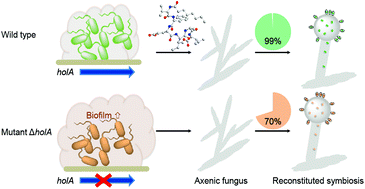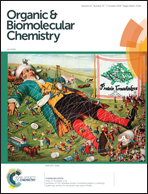Genomics-driven discovery of a linear lipopeptide promoting host colonization by endofungal bacteria†
Abstract
The rice seedling blight fungus Rhizopus microsporus weakens or kills plants by means of a potent toxin produced by endobacteria (Burkholderia rhizoxinica) that live within the fungal hyphae. The success of the highly attuned microbial interaction is partly based on the bacteria's ability to roam and re-colonize the fungal host. Yet, apart from the toxin, chemical mediators of the symbiosis have remained elusive. By genome mining and comparison we identified a cryptic NRPS gene cluster that is conserved among all sequenced Rhizopus endosymbionts. Metabolic profiling and targeted gene inactivation led to the discovery of a novel linear lipopeptide, holrhizin A, which was fully characterized. Through in vitro and in vivo assays we found that holrhizin acts (A) as a biosurfactant to reduce surface tension, (B) influences the formation of mature biofilms and thus cell motility behavior that ultimately supports the bacterial cells to (C) colonize and invade the fungal host, consequently supporting the re-establishment of the exceptional Burkholderia-Rhizopus symbiosis. We not only unveil structure and function of an linear lipopeptide from endofungal bacteria but also provide a functional link between the symbiont's orphan NRPS genes and a chemical mediator that promotes bacterial invasion into the fungal host.

- This article is part of the themed collection: Chemical Biology in OBC


 Please wait while we load your content...
Please wait while we load your content...